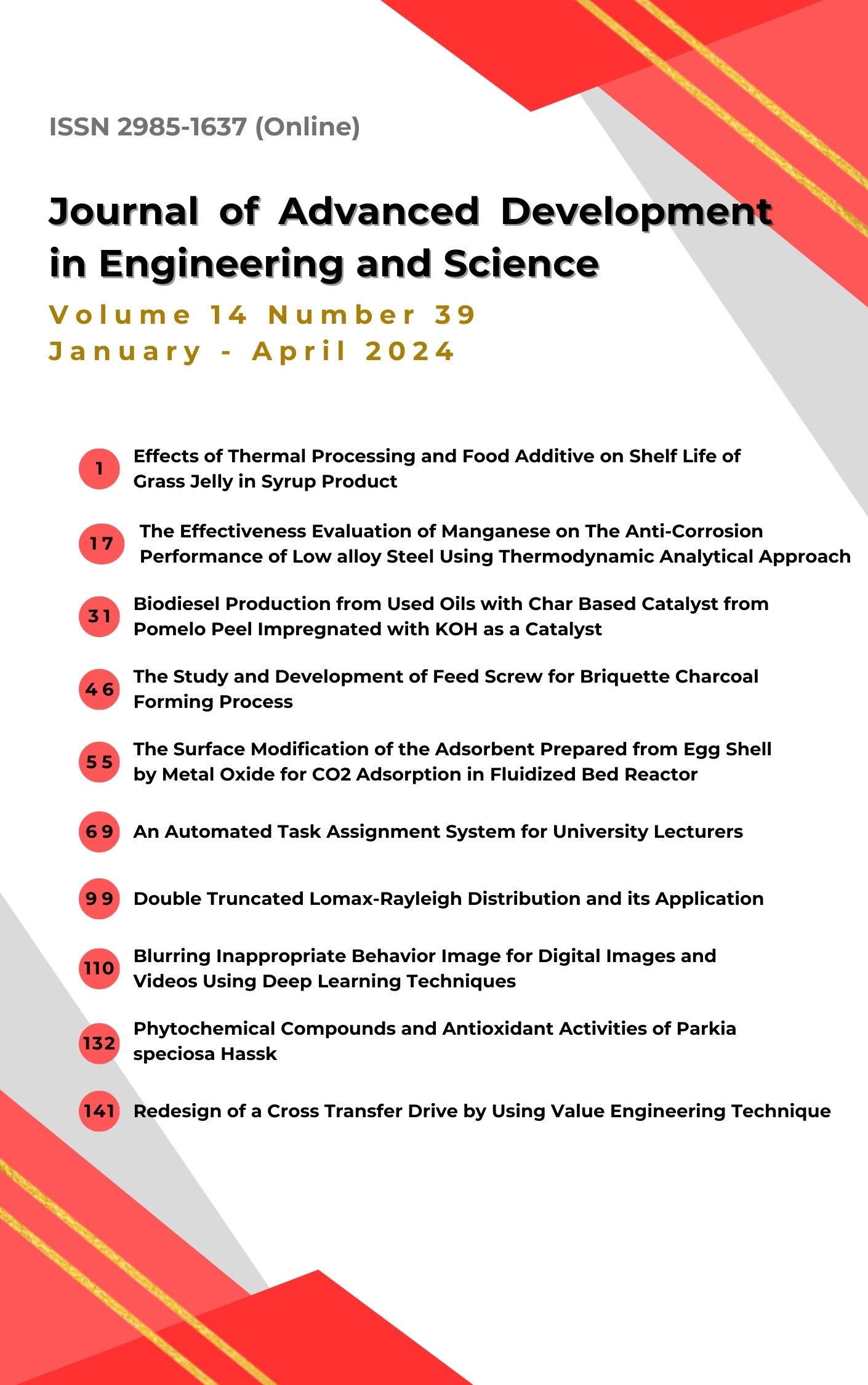การศึกษาและพัฒนาสกรูเดือยหมูสำหรับกระบวนการขึ้นรูปถ่านอัดแท่ง
Main Article Content
บทคัดย่อ
งานวิจัยนี้กล่าวถึงการศึกษาและพัฒนาสกรูเดือยหมูสำหรับกระบวนการขึ้นรูปถ่านอัดแท่งโดยมีวัตถุประสงค์เพื่อแก้ปัญหาการสึกหรอของสกรูเดือยหมูในกระบวนการขึ้นรูปถ่านอัดแท่ง แบบจำลองถูกออกแบบด้วยโปรแกรม SolidWorks และวิเคราะห์ผลด้วยไฟไนท์อิลิเมนต์ โดยเริ่มต้นจากกำหนดให้สกรูเดือยหมูมีขนาดเส้นผ่านศูนย์กลางเท่ากับ 75 มิลลิเมตร ความยาวรวม 457 มิลลิเมตร ระยะเกลียวยาว 300 มิลลิเมตร เกลียวรูปทรงสี่เหลี่ยมคางหมูจำนวน 7 ร่องเกลียว ระยะพิตช์คงที่ 40 มิลลิเมตร โคนเกลียวกว้าง 17.40 มิลลิเมตร หน้าเกลียวทั้งด้านหน้าและด้านหลังเอียงทำมุม 70 องศา สันเกลียวสูง 14 มิลลิเมตร จากนั้นทำการแปรค่าความหนาของสันเกลียว และมุมเอียงสันเกลียวทั้งด้านหน้าและด้านหลัง ผลการจำลองและวิเคราะห์ความแข็งแรง แสดงให้เห็นว่าการเพิ่มความชันสันเกลียวส่งผลให้อายุการใช้งานของสกรูเดือยหมูนั้นลดลง เนื่องจากค่าความเค้นสูงสุดที่เพิ่มมากขึ้น ขณะที่ความหนาของสันเกลียวก็ส่งผลให้ความทนทานการสึกหรอก็เพิ่มขึ้นด้วยเช่นกัน ดังนั้นการปรับสันเกลียวด้านหน้าให้มีความชันมากขึ้นและเพิ่มความหนาของสันเกลียวจึงให้ผลดีมากกว่าผลเสีย
Article Details

This work is licensed under a Creative Commons Attribution-NonCommercial-NoDerivatives 4.0 International License.
เนื้อหาและข้อมูลในบทความที่ลงตีพิมพ์ใน Journal of Advanced Development in Engineering and Science ถือเป็นข้อคิดเห็นและความรับผิดชอบของผู้เขียนบทความโดยตรง ซึ่งกองบรรณาธิการวารสารไม่จำเป็นต้องเห็นด้วยหรือร่วมรับผิดชอบใดๆ
บทความ ข้อมูล เนื้อหา ฯลฯ ที่ได้รับการตีพิมพ์ในJournal of Advanced Development in Engineering and Science ถือเป็นลิขสิทธิ์ของ Journal of Advanced Development in Engineering and Science หากบุคคลหรือหน่วยงานใดต้องการนำทั้งหมดหรือส่วนหนึ่งส่วนใดไปเผยแพร่ต่อหรือเพื่อกระทำการใดๆ จะต้องได้รับอนุญาตเป็นลายลักษณ์อักษรจาก Journal of Advanced Development in Engineering and Scienceก่อนเท่านั้น
References
Department of Alternative Energy and Energy Efficiency. (2020). Ministry of energy. Available From https://www.dede.go.th/ewt_w3c/ewt_dl_link.php?nid=43412. Accessed date: 17 January 2020. (in Thai)
Kuti, O. A. (2009). Performance of Composite Sawdust Briquette Fuel in a Biomass Stove under Simulated Condition. AU Journal of Technology, 12(4), 284–288.
Singh, R. N. (2008). Equilibrium Moisture Content of Biomass Briquettes. Biomass and Bioenergy, 26(3), 251–253.
Rerkkumsup, P., et al. (2020).The Development of an Automatic Control System for Charcoal Briquettes Drying. Pathumwan Academic Journal, 10(27), 70–83. (in Thai)
Onuegbu, T. U., et al. (2010). Enhancing the Properties of Coal Briquette Using Spear Grass (Imperate Cylindrica). Leonardo Journal of Sciences, 17, 47–58.
Jittabu, P. (2015). Physical and Thermal Properties of Briquette Fuels from Rice Straw and Sugarcane Leaves by Mixing Molasses. Energy Procedia, 79, 2–9.
Oliveira, R. S. D., et al. (2017). Briquettes Production for Use as Power Source for Combustion using Charcoal Thin Waste and Sanitary Sewage Sludge. Environmental Science and Pollution Research, 24(11), 10778–10785.
Ravuna, S., et al. (2016). Automatic Screw Press Briquette Making Machine. International Journal of Novel Research in Electrical and Mechanical Engineering, 3(1),19-23.
Nikihil, J., et al. (2016). Briquettes making machine for industrial and agricultural purpose. International Research Journal of Engineering and Technology. 5(2), 594-598.
Ramanchit, S. (2019). Design and development of charcoal screw press briquette machine with automatic cutting. Journal of Industrial Technology, 14(2), 68-72. (in Thai)
Youman, P. (2016). Development of a Cold Production Biomass Charcoal Briquette Machine to use Waste from Coffee Bean Processing. Industrial Technology Lampang Rajabhat University Journal, 9(1), 34-48. (in Thai)
Wirunphan, K., et al. (2016). The Comparison of Wear Rate and Lifetime of the Spiral Fuel Briquette Extrusion from Different Quenching Media of Hardening. Thai Industrial Engineering Network Journal, 2(2), 21-27. (in Thai)
SolidWorks [Computer software]. Dassault Systems.
Jingzhi, Z., et al. (2016). Application of Parametric Modeling Technology in Single Screw Extruder. International Journal of Mechatronics and Applied Mechanics, 1(8), 250-255.
Epifantsev, K. & Mishura, T. (2018). Research Defects of Fatigue Failure of Screws in Solid Works Instrumentation. Open Access Journal of Science, 2(3), 208-210.
